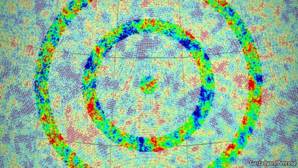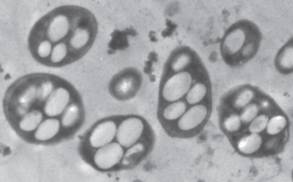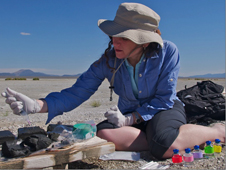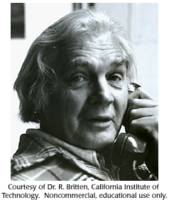What'sNEW November–December 2010
 24 December 2010 24 December 2010
We do see substitutes, what level of substitution, we're not sure; we're not clear about that. — Felisa Wolfe-Simon, following the announcement that certain bacteria can substitute arsenic for phosphorus.
 ...Discoverer of Arsenic Bacteria, in the Eye of the Storm, interview by Elizabeth Pennisi, ScienceNow, 20 Dec 2010. ...Discoverer of Arsenic Bacteria, in the Eye of the Storm, interview by Elizabeth Pennisi, ScienceNow, 20 Dec 2010.
 Scientists from Arsenic Bacteria Paper Respond to Criticisms by Nancy Atkinson, Universe Today, 16 Dec 2010. Scientists from Arsenic Bacteria Paper Respond to Criticisms by Nancy Atkinson, Universe Today, 16 Dec 2010.
 Some bacteria can substitute arsenic for phosphorus is our first notice of this story, 2 Dec, with followup, 8 Dec 2010. Some bacteria can substitute arsenic for phosphorus is our first notice of this story, 2 Dec, with followup, 8 Dec 2010.
 Bacteria: The Space Colonists is the main related local webpage. Bacteria: The Space Colonists is the main related local webpage.
 Thanks, Larry Klaes. Thanks, Larry Klaes.
 23 December 2010 23 December 2010
Our data support the idea that a primordial xyloglucan-like polymer emerged in streptophyte algae as a pre-adaptation that allowed plants to subsequently colonize terrestrial habitats. This comment comes from two Brazilian geneticists who conducted a detailed phylogenetic analysis of the xyloglucan-related enzymatic machinery in green plants.In cosmic ancestry, genetic programs precede the phenotypic expression of themselves. Therefore, we are not surprised by another example of a genetic program that was apparently available before there was any opportunity on Earth for mutation-and-natural-selection to affect it. But how does darwinism account for "pre-adaptation"?
 Luiz Eduardo V Del Bem and Michel GA Vincentz, "Evolution of xyloglucan-related genes in green plants" [abstract], doi:10.1186/1471-2148-10-341, n341 v10, BMC Evolutionary Biology, online 5 Nov 2010. Luiz Eduardo V Del Bem and Michel GA Vincentz, "Evolution of xyloglucan-related genes in green plants" [abstract], doi:10.1186/1471-2148-10-341, n341 v10, BMC Evolutionary Biology, online 5 Nov 2010.
 Metazoan Genes Older Than Metazoa? is the main local webpage about genes that precede the features they encode. Metazoan Genes Older Than Metazoa? is the main local webpage about genes that precede the features they encode.
 20 December 2010 20 December 2010
Other cosmologists claim to see beyond the big bang. This work (unrelated to the announcement by Gurzadyan and Penrose discussed 12-14 December, below) reinforces the claim that the map of the cosmic microwave background radiation can provide evidence of an age before the big bang.
 Stephen M. Feeney et al., "First Observational Tests of Eternal Inflation: Analysis Methods and WMAP 7-Year Results" [abstract], arXiv:1012.3667v1 [astro-ph.CO], submitted 16 Dec 2010. Stephen M. Feeney et al., "First Observational Tests of Eternal Inflation: Analysis Methods and WMAP 7-Year Results" [abstract], arXiv:1012.3667v1 [astro-ph.CO], submitted 16 Dec 2010.
 Cosmic Radiation Features Could Suggest Our Universe Is Not Alone by Jon Cartwright, ScienceNow, 13 Dec 2010. Cosmic Radiation Features Could Suggest Our Universe Is Not Alone by Jon Cartwright, ScienceNow, 13 Dec 2010.
 The End and the Big Bang is a local webpage with related discussion and links. The End and the Big Bang is a local webpage with related discussion and links.
 14 December 2010 14 December 2010
Recent evidence for a cyclic universe is challenged. The result obtained by Gurzadyan and Penrose does not in any way provide evidence for Penrose's cyclical model of the Universe over standard inflation, says James Zibin of the University of British Columbia. Three independent studies reproduced their analysis of the microwave background radiation map, and all agree that the data do contain low-variance circles. Where they part company with the earlier work is in the significance that they attribute to these circles. Gurzadyan and Penrose reply, maintaining their original position. Meanwhile, we wonder if we really know precisely when, how, or if, the universe began?
 No evidence of time before Big Bang by Edwin Cartlidge, doi:10.1038/news.2010.665, NatureNews, online 10 Dec 2010: with links to arXiv abstracts by I.K. Wehus & H.K. Eriksen, Adam Moss et al. and Amir Hajian; and a response by V.G.Gurzadyan and R.Penrose. No evidence of time before Big Bang by Edwin Cartlidge, doi:10.1038/news.2010.665, NatureNews, online 10 Dec 2010: with links to arXiv abstracts by I.K. Wehus & H.K. Eriksen, Adam Moss et al. and Amir Hajian; and a response by V.G.Gurzadyan and R.Penrose.
 12 December 2010 12 December 2010
 ...The existence of an aeon preceding our Big Bang is proposed by a pair of cosmologists who theorize that huge explosions in the late stages of a prior universe would leave traces detectable today. The traces would appear as concentric circles of "anomolously low temperature variance" in the map of the cosmic microwave background radiation. The circles (highlighted in figure) are there, they say, allowing them "'to see through' the big bang into the previous aeon." They name their theory Conformal Cyclic Cosmology (CCC). In it there is no beginning and no end of existence.
...The existence of an aeon preceding our Big Bang is proposed by a pair of cosmologists who theorize that huge explosions in the late stages of a prior universe would leave traces detectable today. The traces would appear as concentric circles of "anomolously low temperature variance" in the map of the cosmic microwave background radiation. The circles (highlighted in figure) are there, they say, allowing them "'to see through' the big bang into the previous aeon." They name their theory Conformal Cyclic Cosmology (CCC). In it there is no beginning and no end of existence.
In cosmic ancestry, life can neither originate from nonlife, nor compose genetic programs for higher life forms. Therefore, life must come from the eternal past. In the standard big bang theory, of course, the past is finite, not eternal. Logically, therefore, we must question this limitation of the big bang theory. Fortunately, we are not the only ones with questions about the standard big bang.
The authors of the new CCC scenario do not specify how life could persist through a big bang. But they are well-credentialed cosmologists, challenging the prevailing belief that there was only one big bang, with nothing before it. Good.
 V.G.Gurzadyan and R.Penrose, "Concentric circles in WMAP data may provide evidence of violent pre-Big-Bang activity" [abstract], arXiv:1011.3706v1 [astro-ph.CO], submitted 16 Nov 2010. V.G.Gurzadyan and R.Penrose, "Concentric circles in WMAP data may provide evidence of violent pre-Big-Bang activity" [abstract], arXiv:1011.3706v1 [astro-ph.CO], submitted 16 Nov 2010.
 "Going round in circles" [html], The Economist, 2 Dec 2010. "In contradiction to most cosmologists' opinions, two scientists have found evidence that the universe may have existed for ever." "Going round in circles" [html], The Economist, 2 Dec 2010. "In contradiction to most cosmologists' opinions, two scientists have found evidence that the universe may have existed for ever."
 "Q&A: Roger Penrose" [html], doi:10.1038/4681039a, p1039 v468, Nature, 23/30 Dec 2010. "...My own fantastical scheme that the entire history of the Universe is just one stage in a succession." "Q&A: Roger Penrose" [html], doi:10.1038/4681039a, p1039 v468, Nature, 23/30 Dec 2010. "...My own fantastical scheme that the entire history of the Universe is just one stage in a succession."
 Penrose claims to have glimpsed universe before Big Bang, PhysicsWorld.com, 19 Nov 2010. Penrose claims to have glimpsed universe before Big Bang, PhysicsWorld.com, 19 Nov 2010.
 Thanks, Marcy Stone and Bob Lee. Thanks, Marcy Stone and Bob Lee.
 The End and the Big Bang is a local webpage with related discussion and links. The End and the Big Bang is a local webpage with related discussion and links.
 Comparing Darwinism, Creationism/ID and Cosmic Ancestry is a related local webpage. Comparing Darwinism, Creationism/ID and Cosmic Ancestry is a related local webpage.
 Rebuttal, 14 Dec | Rebuttal, 14 Dec |  Other Cosmologists..., 20 Dec 2010. Other Cosmologists..., 20 Dec 2010.
 Gabriel Manzotti sends some related links, 23 Dec 3010. Gabriel Manzotti sends some related links, 23 Dec 3010.
 11 December 2010 11 December 2010
Our results clearly show that class I RNRs [ribonucleotide reductases] have spread to archaea and eukaryotes via transfers from the bacterial domain.... These enzymes are essential for the production of DNA. If the genes for enzynmes so fundamental can be acquired by transfer, we would doubt that any gene is ineligible to be transferred. In cosmic ancestry, horizontal gene transfer (HGT) is the way species acquire new genetic programs. In strict darwinism, HGT is a surprise.
 Daniel Lundin et al., "Ribonucleotide reduction - horizontal transfer of a required function spans all three domains" [abstract], doi:10.1186/1471-2148-10-383, n383 v10, BMC Evolutionary Biology, 10 Dec 2010. Daniel Lundin et al., "Ribonucleotide reduction - horizontal transfer of a required function spans all three domains" [abstract], doi:10.1186/1471-2148-10-383, n383 v10, BMC Evolutionary Biology, 10 Dec 2010.
 Viruses and Other Gene Transfer Mechanisms is the main related local webpage. Viruses and Other Gene Transfer Mechanisms is the main related local webpage.
What'sNEW about HGT  | |
 8 December 2010 8 December 2010
 Mono Lake extremophiles with large vacuoles. Picture width = c.3.9 μ
Mono Lake extremophiles with large vacuoles. Picture width = c.3.9 μ |
Not everyone is convinced that the arsenate-consuming bacteria gathered from Mono Lake, California, are as different as claimed. Maybe they are merely taking up arsenate and sequestering it in the large vacuoles they contain. It's a great story about adaptation, but it's not ET, says biochemist Gerald Joyce of the Scripps Research Institute in La Jolla CA. So far, the authors of the original paper have not responded.
 Alla Katsnelson, "Microbe gets toxic response" [html], doi:10.1038/468741a, p741 v468, Nature, online 7 Dec 2010. Alla Katsnelson, "Microbe gets toxic response" [html], doi:10.1038/468741a, p741 v468, Nature, online 7 Dec 2010.
 Arsenic-associated bacteria (NASA's claims) by Rosie Redfield, 4 Dec 2010. Arsenic-associated bacteria (NASA's claims) by Rosie Redfield, 4 Dec 2010.
 Critics raise doubts on NASA's arsenic bacteria by Lin Edwards, Physorg.com, 9 Dec 2010. Critics raise doubts on NASA's arsenic bacteria by Lin Edwards, Physorg.com, 9 Dec 2010.
 Some bacteria can substitute arsenic for phosphorus, What'sNEW, 2 Dec 2010. Some bacteria can substitute arsenic for phosphorus, What'sNEW, 2 Dec 2010.
 ...what level of substitution, we're not sure...., What'sNEW, 24 Dec 2010. ...what level of substitution, we're not sure...., What'sNEW, 24 Dec 2010.
 Bacteria: The Space Colonists is the main related local webpage. Bacteria: The Space Colonists is the main related local webpage.
 Thanks, Stan Franklin. Thanks, Stan Franklin.
 2 December 2010 2 December 2010
Some bacteria can substitute arsenic for phosphorus, according to a lab that gathered samples of certain gammaproteobacteria from the bottom of Mono Lake in California and fed them a diet that was depleted in phosphorus. Phosphorus is one of the six elements believed to be absolutely essential for life as we know it, but this diet contained arsenic instead. Although arsenic is chemically similar to phosphorus, it is poisonous to most life. Amazingly, these bacteria were able to survive with little or no phosphorus, apparently by substituting the arsenic for it. We have long been impressed by the range of environments in which bacteria can survive and thrive, but this news startles even us. Life that can live without phosphorus was never observed before now.
 Others are apparently startled also. For example, Ed Weiler, associate administrator for NASA's Science Mission Directorate said, "The definition of life has just expanded." Indeed, lots of hype accompanies the news, released at a NASA press conference in Washington DC at 2PM EST today. Felisa Wolfe-Simon (pictured) of the NASA Astrobiology Institute and the U.S. Geological Survey was the principle researcher for the project, which also included scientists from Arizona State University, Lawrence Livermore National Laboratory, Duquesne University, and the Stanford Synchroton Radiation Lightsource.
Others are apparently startled also. For example, Ed Weiler, associate administrator for NASA's Science Mission Directorate said, "The definition of life has just expanded." Indeed, lots of hype accompanies the news, released at a NASA press conference in Washington DC at 2PM EST today. Felisa Wolfe-Simon (pictured) of the NASA Astrobiology Institute and the U.S. Geological Survey was the principle researcher for the project, which also included scientists from Arizona State University, Lawrence Livermore National Laboratory, Duquesne University, and the Stanford Synchroton Radiation Lightsource.
We are curious to know several things not explained in the Science article or press releases. For example, can this species survive with absolutely no phosphorus? If not, which biomolecules do, and don't, need phosphorus? How widespread among species is this capability? If phosphorus becomes newly available, do the bacteria revert to it? We will update this news article for a few hours, and post followups. Meanwhile, we now see that some bacteria have another, surprising survival capability.
 Felisa Wolfe-Simon et al., "A Bacterium That Can Grow by Using Arsenic Instead of Phosphorus" [abstract], doi:10.1126/science.1197258, Science, online 2 Dec 2010. Felisa Wolfe-Simon et al., "A Bacterium That Can Grow by Using Arsenic Instead of Phosphorus" [abstract], doi:10.1126/science.1197258, Science, online 2 Dec 2010.
 Elizabeth Pennisi, "What Poison? Bacterium Uses Arsenic to Build DNA and Other Molecules" [summary], doi:10.1126/science.330.6009.1302, p1302 v330, Science, 3 Dec 2010. Elizabeth Pennisi, "What Poison? Bacterium Uses Arsenic to Build DNA and Other Molecules" [summary], doi:10.1126/science.330.6009.1302, p1302 v330, Science, 3 Dec 2010.
 NASA-Funded Research Discovers Life Built With Toxic Chemical by Dwayne Brown and Cathy Weselby, NASA, 2 Dec 2010. NASA-Funded Research Discovers Life Built With Toxic Chemical by Dwayne Brown and Cathy Weselby, NASA, 2 Dec 2010.
 NASA Confirms Discovery of Arsenic-based Life Form by Jane McEntegart, Tom's Guide, 2 Dec 2010. NASA Confirms Discovery of Arsenic-based Life Form by Jane McEntegart, Tom's Guide, 2 Dec 2010.
 NASA scientists find bacteria that can live on arsenic by Dan Vergano, USAToday, 2 Dec 2010. NASA scientists find bacteria that can live on arsenic by Dan Vergano, USAToday, 2 Dec 2010.
 Arsenic and Old Space: A Key to Life on Other Planets? by Michael D. Lemonick, Time, 2 Dec 2010. Arsenic and Old Space: A Key to Life on Other Planets? by Michael D. Lemonick, Time, 2 Dec 2010.
 NASA Finds New Life (Updated) by Jesus Diaz, Gizmodo, 2 Dec 2010. NASA Finds New Life (Updated) by Jesus Diaz, Gizmodo, 2 Dec 2010.
 Arsenic-eating microbe may redefine chemistry of life, doi:10.1038/news.2010.645, by Alla Katsnelson, NatureNews, 2 Dec 2010. Arsenic-eating microbe may redefine chemistry of life, doi:10.1038/news.2010.645, by Alla Katsnelson, NatureNews, 2 Dec 2010.
 Bacteria stir debate about 'shadow biosphere' by Marc Kaufman, The Washington Post, 3 Dec 2010. Bacteria stir debate about 'shadow biosphere' by Marc Kaufman, The Washington Post, 3 Dec 2010.
 Bacteria: The Space Colonists is the main related local webpage. Bacteria: The Space Colonists is the main related local webpage.
 It's a great story about adaptation, but it's not ET, What'sNEW, 8 Dec 2010. It's a great story about adaptation, but it's not ET, What'sNEW, 8 Dec 2010.
 Thanks, Larry Klaes, George Stratton, Walter Klyce, Jim Galasyn, Ronnie McGhee, Polly Klyce, Stan Franklin and Bob Sweeney. Thanks, Larry Klaes, George Stratton, Walter Klyce, Jim Galasyn, Ronnie McGhee, Polly Klyce, Stan Franklin and Bob Sweeney.
 "Her Discovery Wasn’t Alien Life, but Science Has Never Been the Same" [link], The New York Times, 11 Feb 2025. "Her Discovery Wasn’t Alien Life, but Science Has Never Been the Same" [link], The New York Times, 11 Feb 2025.
 22 November 2010 22 November 2010
More microbes are found surviving beyond 100,000 years. Researchers at Binghamton University cultured them from sealed inclusions in tiny salt crystals found in California, Michigan, Kansas and Italy. "Not only did we find bacteria, we found several types of algae as well," team member J. Koji Lum notes. The research suggests that low-level metabolism has continued for that long, in spite of high salinity and temperatures, and no sunlight.
 Tiny salt crystal with sealed inclusions [no scale]
Tiny salt crystal with sealed inclusions [no scale] |
Of course, bacteria that become spores may remain viable indefinitely, and the revival of bacteria trapped in Costa Rican amber at least 25 million years old has already been reported. Now, their apparent capability to actually conduct metabolism in such tiny "time capsules" adds to our amazement. The hardiness of these microbes leads the team to suggest that similar long-survivors may well be found on Mars.
Biologist Lum also remarks, "The things that aren't alive in there, their DNA is still preserved." If their genes have no expiration date, could they remain suitable for installation forever? All of this would be consistent with cosmic ancestry.
 Researchers kick-start ancient DNA, EurekAlert!, 22 Nov 2010. Researchers kick-start ancient DNA, EurekAlert!, 22 Nov 2010.
 Researchers jump-start ancient DNA, Binghamton University, 22 Nov 2010. Researchers jump-start ancient DNA, Binghamton University, 22 Nov 2010.
 Scientists open tiny 'time capsules' in search of ancient DNA by Rachel Coker, Binghamton University, 19 Oct 2010. Scientists open tiny 'time capsules' in search of ancient DNA by Rachel Coker, Binghamton University, 19 Oct 2010.
 Bacteria: The Space Colonists has links and discussion about other long-surviving bacteria, including the Costa Rican ones. Bacteria: The Space Colonists has links and discussion about other long-surviving bacteria, including the Costa Rican ones.

 21 November 2010 21 November 2010
The human genome contains about 1.8 million recognizable Alu sequence residues, which have been inserted over many tens of millions of years of primate evolution.... They are now seen as having much structural and evolutionary significance — Roy Britten (pictured), Distinguished Carnegie Senior Research Associate in Biology, Emeritus at caltech
 Roy J. Britten, "Transposable element insertions have strongly affected human evolution" [abstract], doi:10.1073/pnas.1014330107, Proc. Natl. Acad. Sci. USA, online 1 Nov 2010. Roy J. Britten, "Transposable element insertions have strongly affected human evolution" [abstract], doi:10.1073/pnas.1014330107, Proc. Natl. Acad. Sci. USA, online 1 Nov 2010.
 Viruses and Other Gene Transfer Mechanisms is a related local webpage. Viruses and Other Gene Transfer Mechanisms is a related local webpage.
What'sNEW about HGT  | |
 Human Genome Search... is a related local webpage. Human Genome Search... is a related local webpage.
 19 November 2010 19 November 2010
...Genetic material derived from all known viral genome types and replication strategies can enter the animal germ line, ...indicating a more significant evolutionary role for gene flow from virus to animal genomes than has previously been recognized — Katzourakis & Gifford
 A Katzourakis and RJ Gifford, "Endogenous Viral Elements in Animal Genomes"
[html], PLoS Genet 6(11): e1001191. doi:10.1371/journal.pgen.1001191, 18 Nov 2010. A Katzourakis and RJ Gifford, "Endogenous Viral Elements in Animal Genomes"
[html], PLoS Genet 6(11): e1001191. doi:10.1371/journal.pgen.1001191, 18 Nov 2010.
 WE Johnson, "Endless Forms Most Viral"
[html], PLoS Genet 6(11): e1001210. doi:10.1371/journal.pgen.1001210, 18 Nov 2010. WE Johnson, "Endless Forms Most Viral"
[html], PLoS Genet 6(11): e1001210. doi:10.1371/journal.pgen.1001210, 18 Nov 2010.
 All viruses 'are potential stowaways in our DNA', University of Oxford, 19 Nov 2010. All viruses 'are potential stowaways in our DNA', University of Oxford, 19 Nov 2010.
 Animal genomes riddled with the 'skeletons' of ancient viruses posted by Ewen Callaway on nature.com, 18 Nov 2010. Animal genomes riddled with the 'skeletons' of ancient viruses posted by Ewen Callaway on nature.com, 18 Nov 2010.
 Viruses and Other Gene Transfer Mechanisms is the main related local webpage. Viruses and Other Gene Transfer Mechanisms is the main related local webpage.
What'sNEW about HGT  | |
 Thanks, EurekAlert, Jim Galasyn and Stan Franklin. Thanks, EurekAlert, Jim Galasyn and Stan Franklin.
 7 November 2010 7 November 2010
Search the Cosmic Ancestry Website with a new tool, supplied by Google [until c. 2017], linked from most navigation bars, as above.
 Search the Cosmic Ancestry Website. Search the Cosmic Ancestry Website.
 Thanks, Ron McGhee, for the suggestion. Thanks, Ron McGhee, for the suggestion.
 6 November 2010 6 November 2010
Chandra Wickramasinghe reviews the case for cometary panspermia.
 Microfossils in comet dust and meteorites support panspermia by Chandra Wickramasinghe, doi:10.1117/2.1201010.003239, SPIE, 4 Nov 2010. Microfossils in comet dust and meteorites support panspermia by Chandra Wickramasinghe, doi:10.1117/2.1201010.003239, SPIE, 4 Nov 2010.
 Chandra Wickramasinghe is a related local webpage. Chandra Wickramasinghe is a related local webpage.
 Thanks, Google Alerts. Thanks, Google Alerts.
 2 November 2010 2 November 2010
The software problem for the origin of life is not ignored, for once – in a new article about panspermia:
"It has been known for a long while that random chemical interactions cannot produce the genetic information of the organisms we currently see on Earth.... For example, in a model of the prebiotic Earth with an appropriate complement of amino acids, random molecular interactions over a period of 500 x 10^6 yr would produce only about 194 bits of information.... This is... tiny compared to the 6 x 10^6 bits in a bacterium like E. Coli. The low gain in information I from N trials is because the two things are related by I = log2 N."
 The writer, astrophysicist Paul S. Wesson of the University of Waterloo, therefore considers panspermia, by logic much like ours: "There are in principle two ways to circumvent this problem. One is that life in fact evolved solely on the Earth, but by some non-random, directed molecular process. The other is that life evolved on the Earth and other planets because they were seeded by biological molecules which already had a large information content. Both of these hypotheses have objections; but in view of the near-inevitability of this process shown above, the second appears to be the more plausible. ...Natural processes do not account for the genomes of observed organisms, basically because of the slow accumulation of genetic information. By contrast, the hypothesis that some information was present at the outset, while it does not solve the problem, certainly alleviates it."
The writer, astrophysicist Paul S. Wesson of the University of Waterloo, therefore considers panspermia, by logic much like ours: "There are in principle two ways to circumvent this problem. One is that life in fact evolved solely on the Earth, but by some non-random, directed molecular process. The other is that life evolved on the Earth and other planets because they were seeded by biological molecules which already had a large information content. Both of these hypotheses have objections; but in view of the near-inevitability of this process shown above, the second appears to be the more plausible. ...Natural processes do not account for the genomes of observed organisms, basically because of the slow accumulation of genetic information. By contrast, the hypothesis that some information was present at the outset, while it does not solve the problem, certainly alleviates it."
He proposes a new name, necropanspermia, for the delivery of valid genetic programs by fragmented or dead cells or viruses: "The version of the standard theory wherein life restarts from technically dead but information-carrying material may be dubbed necropanspermia. It avoids the problem that random chemical processes cannot account for the information encoded in the genomes of even simple Earthly organisms."
We have a few technical quibbles with him, for example, when he writes: "The potato spindle tuber viroid is among the smallest, self-replicating pathogens known...." But viruses require whole cells to carry out their replication. Also, "Life is a process that generates information, whereas many other processes generate entropy (misinformation)." Because almost anything can be called "information", the term is often misleading. We would say instead: Life is a phenomenon that requires a special kind of information, encoded programs. No natural process has been clearly shown to generate these. Wesson observes this clearly.
Our quibbles are minor compared to our gratitude for his giving panspermia a probing and imaginative analysis. We especially welcome the suggestion that "some information [encoded in the genomes] was present at the outset," a radical idea to almost everyone but us. And he assigns to viruses an even greater role than we do; we thought no one did that! He also discusses in depth the survivability of viable cells, viruses and genomic fragments in space. The complete article is available online.
 Paul S. Wesson, "Panspermia, Past and Present: Astrophysical and Biophysical Conditions for the Dissemination of Life in Space" [abstract | 33-page PDF], arXiv.org > astro-ph > arXiv:1011.0101v1, 30 Oct 2010; and [14-page PDF], doi:10.1007/s11214-010-9671-x, Space Science Reviews, online 14 Jul 2010. Paul S. Wesson, "Panspermia, Past and Present: Astrophysical and Biophysical Conditions for the Dissemination of Life in Space" [abstract | 33-page PDF], arXiv.org > astro-ph > arXiv:1011.0101v1, 30 Oct 2010; and [14-page PDF], doi:10.1007/s11214-010-9671-x, Space Science Reviews, online 14 Jul 2010.
 All Life on Earth Could Have Come From Alien Zombies by Lisa Grossman, Wired Science, 10 Nov 2010. All Life on Earth Could Have Come From Alien Zombies by Lisa Grossman, Wired Science, 10 Nov 2010.
 Did Life on Earth Start With a Zombie Virus From Outer Space? by Nitasha Tiku, New York Magazine, 10 Nov 2010. Did Life on Earth Start With a Zombie Virus From Outer Space? by Nitasha Tiku, New York Magazine, 10 Nov 2010.
 Introduction: More Than Panspermia is a related local webpage. Introduction: More Than Panspermia is a related local webpage.
 The RNA World is the main local webpage about origin-of-life theories. The RNA World is the main local webpage about origin-of-life theories.
 Is Sustained Macroevolutionary Progress Possible? is one of several local webpages questioning the standard account of new genetic programs. Is Sustained Macroevolutionary Progress Possible? is one of several local webpages questioning the standard account of new genetic programs.
 Metazoan Genes Older Than Metazoa? is a local webpages with examples of genes older than they ought to be according to standard theory. Metazoan Genes Older Than Metazoa? is a local webpages with examples of genes older than they ought to be according to standard theory.
 Viruses and Other Gene Transfer Mechanisms — discussion and links about viruses' role in evolution. Viruses and Other Gene Transfer Mechanisms — discussion and links about viruses' role in evolution.
What'sNEW about HGT  | |
 Thanks, Google Alerts. Thanks, Google Alerts.

|
 ...The existence of an aeon preceding our Big Bang is proposed by a pair of cosmologists who theorize that huge explosions in the late stages of a prior universe would leave traces detectable today. The traces would appear as concentric circles of "anomolously low temperature variance" in the map of the cosmic microwave background radiation. The circles (highlighted in figure) are there, they say, allowing them "'to see through' the big bang into the previous aeon." They name their theory Conformal Cyclic Cosmology (CCC). In it there is no beginning and no end of existence.
...The existence of an aeon preceding our Big Bang is proposed by a pair of cosmologists who theorize that huge explosions in the late stages of a prior universe would leave traces detectable today. The traces would appear as concentric circles of "anomolously low temperature variance" in the map of the cosmic microwave background radiation. The circles (highlighted in figure) are there, they say, allowing them "'to see through' the big bang into the previous aeon." They name their theory Conformal Cyclic Cosmology (CCC). In it there is no beginning and no end of existence.

 Others are apparently startled also. For example, Ed Weiler, associate administrator for NASA's Science Mission Directorate said, "The definition of life has just expanded." Indeed, lots of hype accompanies the news, released at a NASA press conference in Washington DC at 2PM EST today. Felisa Wolfe-Simon (pictured) of the NASA Astrobiology Institute and the U.S. Geological Survey was the principle researcher for the project, which also included scientists from Arizona State University, Lawrence Livermore National Laboratory, Duquesne University, and the Stanford Synchroton Radiation Lightsource.
Others are apparently startled also. For example, Ed Weiler, associate administrator for NASA's Science Mission Directorate said, "The definition of life has just expanded." Indeed, lots of hype accompanies the news, released at a NASA press conference in Washington DC at 2PM EST today. Felisa Wolfe-Simon (pictured) of the NASA Astrobiology Institute and the U.S. Geological Survey was the principle researcher for the project, which also included scientists from Arizona State University, Lawrence Livermore National Laboratory, Duquesne University, and the Stanford Synchroton Radiation Lightsource.


 The writer, astrophysicist Paul S. Wesson of the University of Waterloo, therefore considers panspermia, by logic much like ours: "There are in principle two ways to circumvent this problem. One is that life in fact evolved solely on the Earth, but by some non-random, directed molecular process. The other is that life evolved on the Earth and other planets because they were seeded by biological molecules which already had a large information content. Both of these hypotheses have objections; but in view of the near-inevitability of this process shown above, the second appears to be the more plausible. ...Natural processes do not account for the genomes of observed organisms, basically because of the slow accumulation of genetic information. By contrast, the hypothesis that some information was present at the outset, while it does not solve the problem, certainly alleviates it."
The writer, astrophysicist Paul S. Wesson of the University of Waterloo, therefore considers panspermia, by logic much like ours: "There are in principle two ways to circumvent this problem. One is that life in fact evolved solely on the Earth, but by some non-random, directed molecular process. The other is that life evolved on the Earth and other planets because they were seeded by biological molecules which already had a large information content. Both of these hypotheses have objections; but in view of the near-inevitability of this process shown above, the second appears to be the more plausible. ...Natural processes do not account for the genomes of observed organisms, basically because of the slow accumulation of genetic information. By contrast, the hypothesis that some information was present at the outset, while it does not solve the problem, certainly alleviates it."